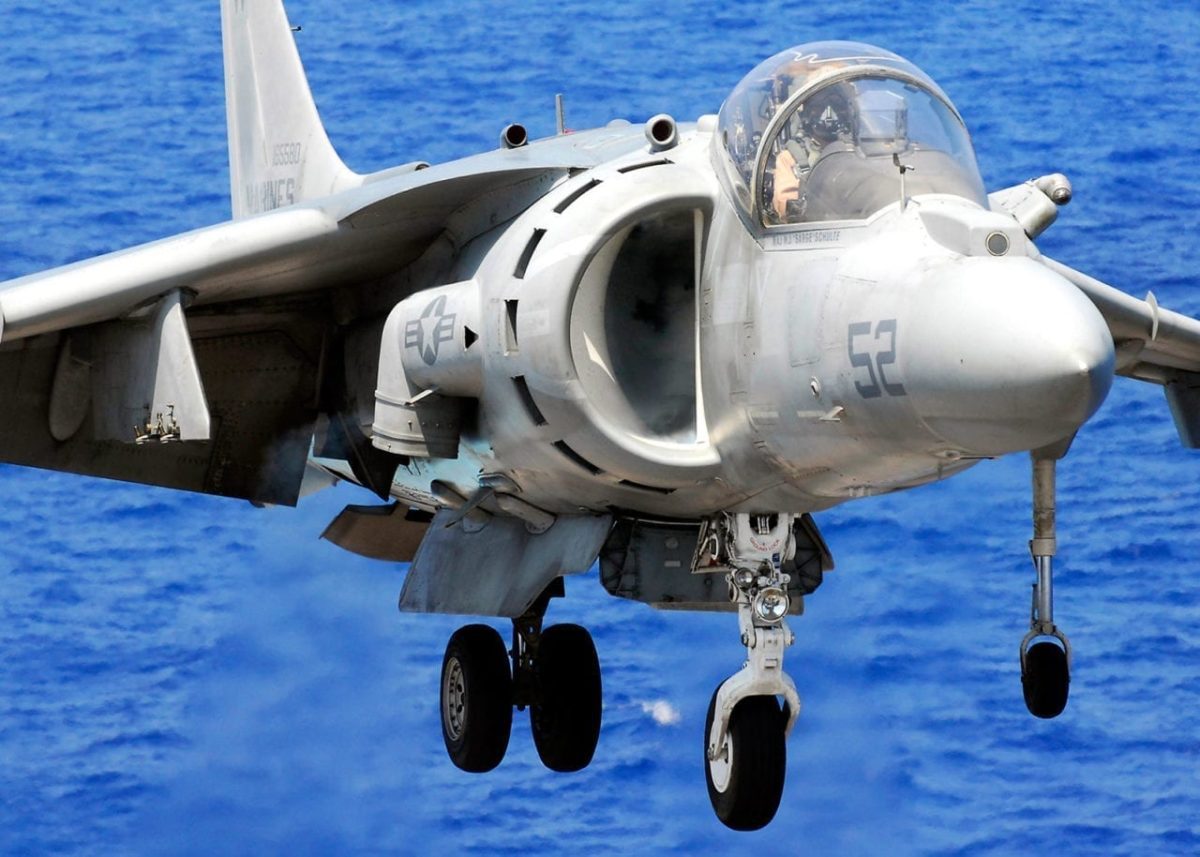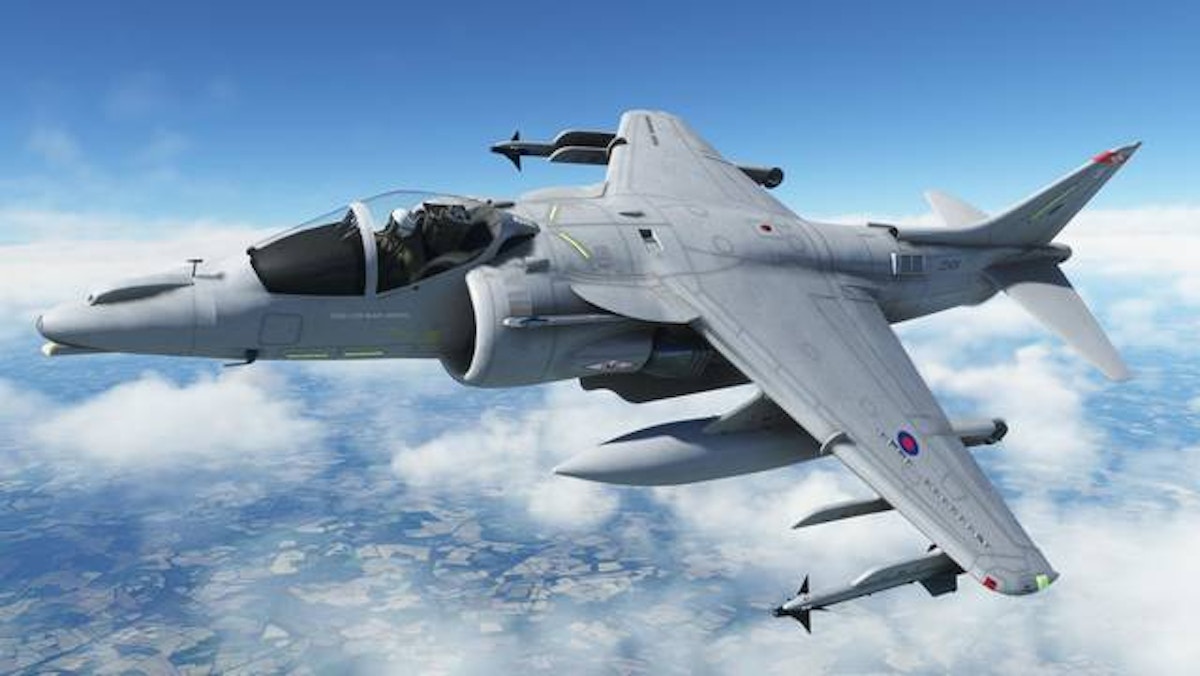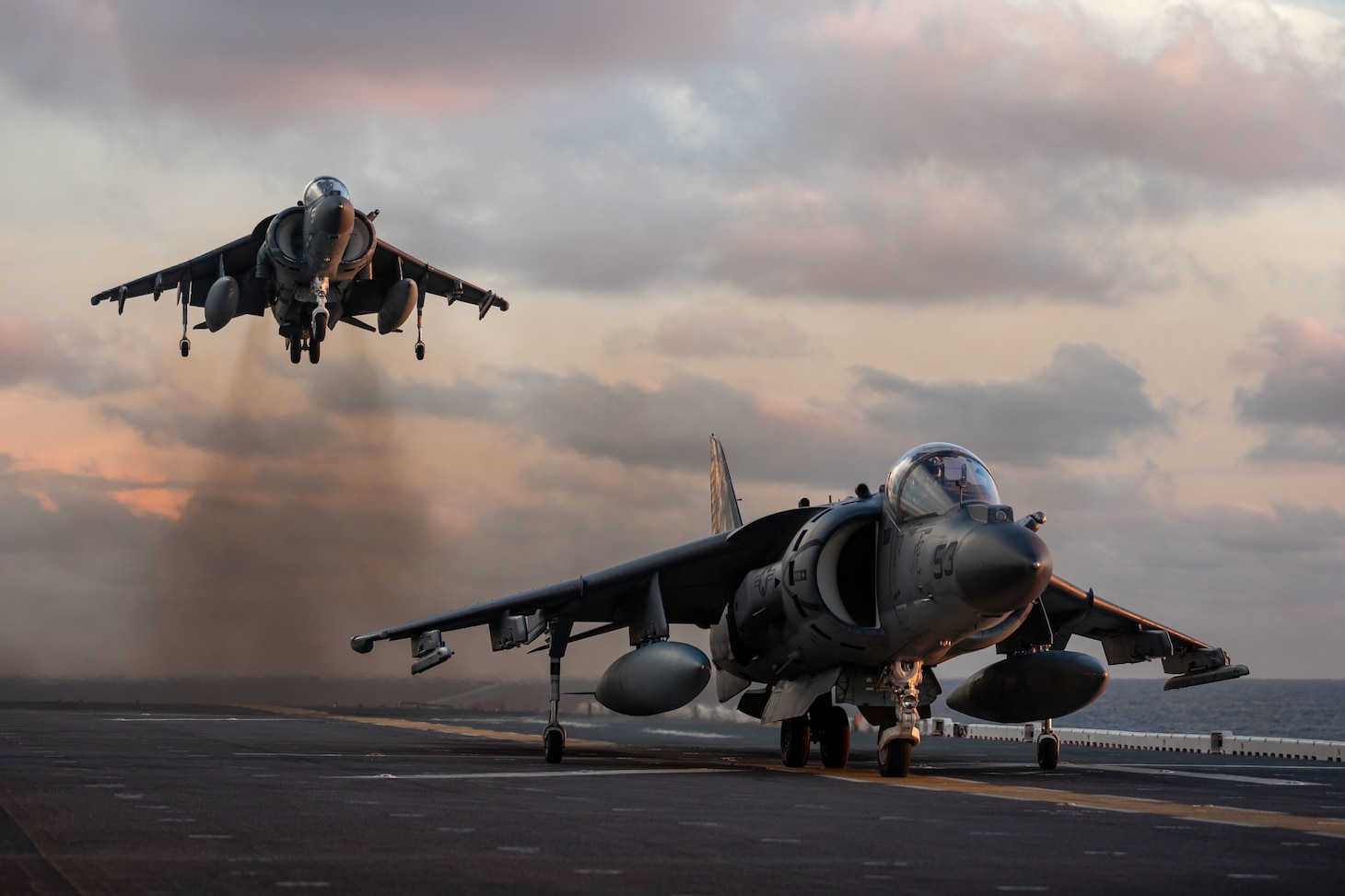Av8b Harrier Jet - Service: USMC Propulsion: Rolls Royce Pegasus F402-RR-406 turbocharged engine Armament: 25mm GAU-12 cannon; 4x LAU-5003 rocket cases; 4x AIM-9 Sidewinders; 6x AIM-120 AMRAAM; 6x AGM-65 Maverick; 2x AGM-84 Harp; 2x AGM-88 HARM; Mark 80 bombs; laser guided bombs; Direct attack common ammunition Speed: 550 kts Range: 900 nm
The AV-8B Harrier II is America's only short takeoff and vertical landing jet in the current inventory. First flown in the late 1960s, the Harrier underwent a series of upgrades that increased safety, range and lethality. The AV-8B is a key component of the Marine Corps' "all-powerful STOVL" concept, which enables Marines to provide support in challenging conditions in expeditionary environments.
Av8b Harrier Jet

22,000 pounds of thrust allows the Harrier II to hover like a helicopter, then propel forward like a jet at near supersonic speeds. Like every aircraft in the fleet, this aircraft is capable of attacking and destroying surface and air targets, escorting helicopters, engaging in air defense, providing reconnaissance and providing offensive and defensive support with an arsenal of missiles, bombs and air-to-air missiles. Used for multiple operations. 25 mm cannon. Offering the versatility to perform almost any mission, the Harrier II provides the ideal combination of firepower and mobility for our ground forces to effectively engage engaged enemies.
Av 8b Harrier Jet
The AV-8B V/STOL attack aircraft is designed to replace the AV-8A and A-4M light attack aircraft. The Marine Corps' need for a V/STOL light assault force has been well documented since the late 1950s. The combination of tactical mobility, responsiveness, reduced operational costs, and both water- and land-based flexibility make V/STOL aircraft particularly well-suited to the Marine Corps' special warfare and reconnaissance needs. The AV-8BII+ includes the APG-65 radar common to the F/A-18 as well as all previous systems and functions common to the AV-8BII.
Ukrainian forces have used automatic artillery to try to push Russian forces away from the second-largest army.
Real Top Gun pilots fly through the skies in F-35 fighter jets. These are mostly charged…
Ukrainian soldiers use US M777 howitzers on the battlefield as they try to repel Russian forces ...
Bae Systems To Support U.s. Av 8b Harrier Fleet To 2029
A Marine plane crashed in the Southern California desert on Wednesday, and civilian and emergency crews responded…
Satellite images of Ukraine's Snake Island released Friday show a fleet of sunken Russian vessels.
As the war in Ukraine continues and tensions in the Pacific ease, the Air Force is moving F-16s from Europe to Japan, a move that comes after the Pentagon announced it would remove older F-15 Eagles from Kadena Air Force Base. ...

Navy training plane crashes in Alabama; The T-6B Texan II is a two-seat turboprop aircraft used to train Navy and Marine Corps pilots at the Air Force Academy.
Cobi Av 8b Harrier Ii Plus
The Netherlands says it is sending Patriot aid to Ukraine The Patriot is the most advanced surface-to-air missile system the West has given Ukraine to repel Russian air...
These fast new Naval Medical Ships are designed with the Pacific in mind The recently approved DoD budget for 2023 funds a new type of Naval Medical Ship – a ship built to operate…
The Vietnam War veteran's future destroyer, Secretary of the Navy Carlos Del Toro announced, will name one of the service's new, yet-to-be-built destroyers... Harrier, a family known informally as the Harrier Jump Jet. Jet-powered attack aircraft capable of vertical / short take-off and landing (V/STOL). Named after a bird of prey,
It was originally developed by British manufacturer Hawker Sidley in the 1960s. Of the many attempts at the time, the Harrier proved to be the only successful V/STOL design. It is designed to operate from improvised bases such as parking lots or forest clearings, without the need for large and vulnerable air bases. Later, this design was adapted for use on aircraft carriers.
Av 8b Harrier Ii Retirement Is Stretched To 2030
Developed by UK and US manufacturers, the Harrier family has two generations and four main variants:
The Hawker Siddeley Harrier is the first generation version, also known as the AV-8A or AV-8C Harrier; It was used by several air forces, including the Royal Air Force (RAF) and the United States Marine Corps (USMC). The Sea Harrier is a naval air defense fighter derived from the Hawker Siddeley Harrier; It was operated by the Royal Navy and the Indian Navy. In the 1980s, the second generation of Harriers appeared, produced in the United States as the AV-8B and in Britain as the British Aerospace Harrier II. By the early 2000s, most of the first generation Harriers had been phased out, with many operators opting to purchase the second generation. In the long run, several operators have announced their intention to supplement or replace their Harrier fleets with the STOVL variant of the F-35 Lightning II, designated the F-35B.
In the 1950s, especially in the years following the Korean War, a number of airlines in Europe and America decided to independently explore the future capabilities and feasibility of vertical take-off and landing (VTOL) aircraft, which would eliminate the need for risk-taking. Runway take-off and landing by vertical take-off and landing as opposed to a traditional horizontal approach.

In addition to military applications, the prospect of applying such technology to commercial aircraft was awaited with considerable interest by the mid-1950s, and the value of developing viable vertical takeoff systems was considered significant. However, during this era, several companies saw that a VTOL aircraft could be compatible with the characteristics of high-performance military aircraft.
U.s. Marine Corps Av 8 Harrier Fighter Jet Crashes Off Coast Of Okinawa, Japan
Bottom view of the first P.1127 prototype. Rotary jet nozzles were a key design element of its VTOL capability
In 1957, an approach by British aircraft manufacturer Bristol Jayne Company proposed innovative vectored thrust, and the British Airlines Group Hawker developed its design for an aircraft that could meet NATO specifications requiring "light tactical support". Warrior".
Combined rotating cold jets placed on either side of the compressor with a "hot" jet routed through a conventional central tailpipe; The concept comes from Frch aviation consultant Michel Wibault. The project did not receive any financial support from the Ministry of Finance during most of the initial development work. However, support for the Jin development portion of the effort was provided through NATO's Mutual Weapons Development Program (MWDP).
Sir Ralph Hooper, Hawker's project engineer, immediately set about creating an initial layout of a theoretical aircraft that could take advantage of the Pegasus engine, using data provided by Bristol.
The Exhilarating, Exasperating Life Of The Harrier Jump Jet
In March 1959, the newly incorporated Hawker Siddeley decided to privately finance a pair of prototypes of the design, given the internal company designation P.1127, to demonstrate the design's capabilities.
In the 1960s the P.1127 came to the attention of the RAF; This would eventually lead to the development and release of the Requiremt ASR 384 seeking a V/STOL aircraft for ground attack operations.
Around the same time as the RAF's interest in the concept, NATO began developing its own specification, NBMR-3, which called for vertical take-off and landing (VTOL) aircraft; Among the specific requirements, the performance of such an aircraft is expected to be similar to that of the McDonnell Douglas F-4 Phantom II conventional fighter. Specifications call for a V/STOL supersonic fighter with a combat radius of 460 kilometers (250 nmi), a cruise speed of Mach 0.92 and a speed of Mach 1.5.
In the early 1960s, Hawker began work on developing a supersonic version of the P.1127, designated the P.1150, which culminated in the unsuccessful Hawker P.1154. The NBMR.3 also attracted other competitors, including the P.1154's main competitor, the Dassault Mirage IIIV. P.1154 finally selected in accordance with NBMR-3; However, this did not lead to orders.
Av 8b Harrier Jet Aircraft Doing A Vertical Landing On The Uss Boxer. (2218x1476)
On 6 December 1961, before the proposal was submitted to NATO, it was decided to develop the P.1154 with requirements for use by both the Royal Air Force (RAF) and the Royal Navy (RN).
So this type of development continued for some time; However, in October 1963 the Air Ministry reviewed the progress of the project and noted that the attempt to combine fighter and fighter aircraft into a single aircraft and fit the same airframe for both services was "inadvisable".
On 2 February 1965, work on the P.1154 was canceled by the new British government due to the cost of producing the prototype.
In 1964, the first of them began flight operations; The Kestrel was evaluated by a multinational "Tri-Party Evaluation Squadron" of British, American and German pilots to determine how VTOL aircraft could operate. The evaluations were completed in November 1965.
An Av 8b Harrier Jet Aircraft Lands On The Flight Deck
In 1966, following the cancellation of the P.1154, the RAF decided to order into service a modified P.1127/Kestrel derivative, designated the Harrier GR.1.
The Hawker Siddeley Harrier GR.1/GR.3 and AV-8A Harrier are the first generation of the Harrier series, the first operational close support and reconnaissance attack aircraft with vertical/short take-off and landing (V/STOL) capabilities. These were developed directly from the Hawker P.1127
Av8b harrier 2, av8b harrier ii, harrier jet model, av8b harrier crash, av8b harrier model, av8b harrier demo, harrier av8b, harrier jump jet, harrier jet, harrier jet for sale, harrier jet rc, av8b harrier assault

0 Comments